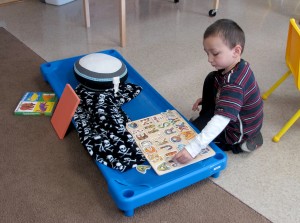Is There A Magic Number That Can Buy Support For State-Funded Pre-K?

Elle Moxley / StateImpact Indiana
A student plays with an alphabet puzzle at Busy Bees Academy, a public preschool in Columbus.
Count Sen. Dennis Kruse, R-Auburn, among those skeptical it will take $6,800 per pupil to launch a high quality, state-funded preschool program.
“I don’t know where they got that high figure,” Kruse told StateImpact. “Who in the world needs $6,800 for pre-K?”
A proposal to create a small-scale pre-K pilot fizzled last month when it reached the panel he chairs, the Senate Education Committee.
Kruse wasn’t the only one questioning the program’s $7 million price tag. Sen. Jean Leising, R-Oldenburg, also wanted to know why the state legislature was considering paying so much for preschool.
We’ve written before about how hard it is to nail down to a good cost estimate for state-funded preschool — depending on who you ask, it could cost as much as $8,000 per pupil or as little as $3,500.
But the number that kept coming up last week? A more modest $4,200. That’s in line with the national average for state-funded preschool programs and a 2012 estimate from the National Institute of Early Education Research that suggested Indiana could get the job done for around $4,130 per student.
Terry Spradlin, the education policy director at Indiana’s University’s Center for Evaluation & Education Policy, says $4,200 per pupil could buy a five-hour, full-day program for at-risk 4-year-olds.“Rather than start with 3- and 4-year-olds universal — let any child who’s 3 and 4 ready for pre-kindergarten enroll and the state pay for that — that’s simply at a cost the state doesn’t have the appetite for, probably can’t afford now,” says Spradlin.
It still wouldn’t come cheap. Even a targeted program could cost Indiana upwards of $125 million a year. Spradlin estimates 30,000 Hoosier kids would be eligible for state-funded preschool each year who aren’t already receiving services through federal special education initiatives or Head Start.
But if $6,800 per pupil was too much, then $4,200 might be just right. Kruse says at that price, more state lawmakers might be willing to get on board with a pilot program in 2015.
“I think we’d be more open in two years than we were this year,” he says.

